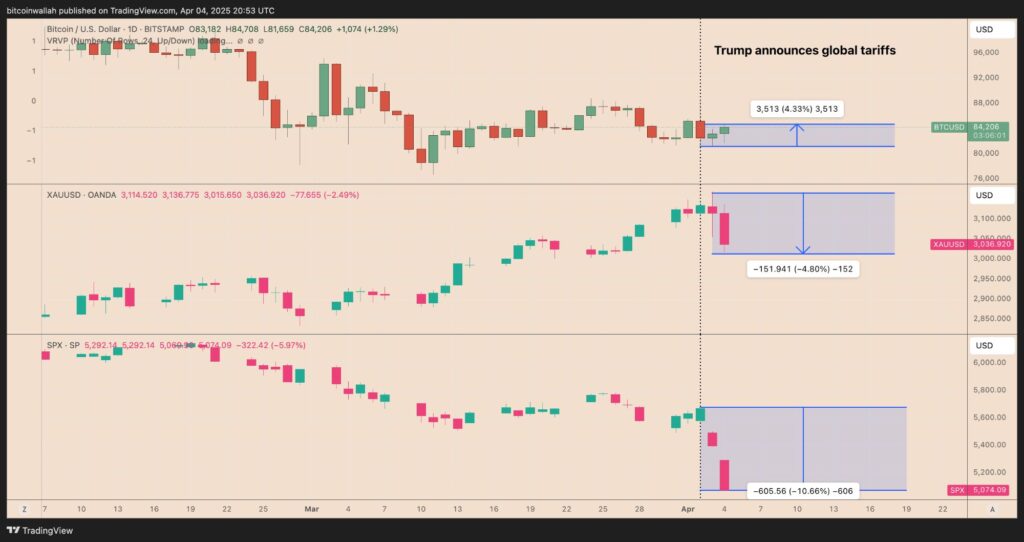
In a week marked by global market turbulence, Bitcoin has demonstrated remarkable resilience, currently trading at $82,960.94 as of April 5, 2025. This price analysis examines Bitcoin’s current position, how it relates to broader market movements, and what leading analysts are projecting for the cryptocurrency’s future.
Market Overview: Bitcoin Defies Stock Market Plunge

The past week has seen unprecedented volatility in traditional markets, with global stock indices experiencing their worst sell-off in five years following President Donald Trump’s announcement of sweeping global tariffs on April 2. The S&P 500 plummeted approximately 10%, erasing an estimated $5 trillion in market value.
Bitcoin initially dropped following the announcement but quickly recovered, demonstrating what market observers are increasingly viewing as a decoupling from traditional equity markets. While the tech-heavy Nasdaq approached bear market territory, Bitcoin has maintained its position above the crucial $80,000 support level, showing unexpected strength amidst broader market chaos.
“Bitcoin’s price action this week has been a true testament to its investment case as an emerging store of value and potential for uncorrelated returns,” said David Hernandez, crypto investment specialist at 21Shares, in a recent statement. Forbes
Bitcoin: The New “Store of Value”?
In a remarkable endorsement, Treasury Secretary Scott Bessent recently declared Bitcoin an emerging “store of value” comparable to gold—a significant recognition from a high-ranking U.S. government official.
“Bitcoin is becoming a store of value, gold has historically been a store of value,” Bessent told podcaster Tucker Carlson, adding there are “a lot of different stores of value over time.” Forbes
This statement comes as gold, a traditional safe-haven asset, has risen approximately 15% this year, with Bitcoin showing similar protective qualities during recent market turmoil.
The “Gold Leads, Bitcoin Follows” Theory Gains Traction
Market analysts are increasingly focusing on the relationship between gold and Bitcoin, with a pattern emerging that suggests Bitcoin could follow gold’s price movements with amplified returns.

Historical data shows that between late 2018 and mid-2019, gold began a steady ascent, gaining nearly 15%, while Bitcoin initially remained flat before experiencing a dramatic breakout. Bitcoin eventually rallied over 170% in early 2019 and surged another 344% by late 2020.
Market analyst MacroScope recently commented on X: “A reclaim of $100k would imply a handoff from gold to BTC. As in previous cycles, this would open the door to a new period of huge outperformance by BTC over gold and other assets.” Cointelegraph
PlanB’s Stock-to-Flow Model and Price Predictions
One of the most closely followed Bitcoin analysts, PlanB, creator of the Stock-to-Flow (S2F) model, maintains his bullish outlook for Bitcoin. His S2F model, which emphasizes Bitcoin’s scarcity relative to its production rate, forecasts significantly higher prices in the coming year.
PlanB has predicted that Bitcoin could reach an average price of $500,000 in 2025, with a potential peak of $1 million per coin and a minimum price of $250,000. This prediction is based on his analysis of Bitcoin’s market cycles, particularly following the recent halving event. Binance
Technical Analysis: Key Support and Resistance Levels
Based on recent price action, Bitcoin has established strong support around the $80,000-$82,000 range, with resistance at the recent high of approximately $88,530 (reached on April 2, 2025).
The cryptocurrency‘s daily trading volume has been volatile but substantial, averaging around $30-40 billion over the past week, indicating robust market participation despite the broader market uncertainty.
Bitcoin’s relative strength against the USD and other major currencies suggests underlying bullish sentiment, even as technical indicators point to a period of consolidation after the recent market shocks.
Risk Factors: Trade War and Recession Concerns
Despite Bitcoin’s recent resilience, several risk factors could impact its trajectory:
- U.S. Recession Fears: Analysts worry that President Trump’s global tariff war could spiral into a full-blown trade war and trigger a U.S. recession, potentially affecting all risk assets, including Bitcoin.
- Fed Interest Rate Policy: Federal Reserve Chair Jerome Powell recently pushed back against expectations for near-term interest rate cuts, warning that inflation progress remains uneven. This could maintain a high-rate environment that may dampen Bitcoin’s upside momentum.
- BTC/XAU Ratio Warning: Some technical analysts point to a potentially bearish fractal in the Bitcoin-to-gold ratio that resembles patterns seen before previous major corrections. If this pattern holds, Bitcoin could see a drop toward the $65,000 level in the near term. Cointelegraph
Analyst Perspectives and Market Sentiment
Market sentiment indicators show mixed signals. The Crypto Fear and Greed Index currently registers in the “Fear” range, indicating caution among market participants despite Bitcoin’s relative price stability.
Joe Burnett, director of market research at financial company Unchained, noted: “Recalling March 2020, bitcoin rapidly bottomed and recovered first (before U.S. equities), a pattern potentially repeating today as bitcoin hasn’t made new lows since March 11th. This resilience could signal a strategic entry point for long-term investors.” Forbes
Conclusion: Bitcoin at a Crossroads
Bitcoin stands at a critical juncture. Its recent performance suggests emerging qualities as a store of value and potential decoupling from traditional markets, particularly amid geopolitical and economic uncertainties. The cryptocurrency’s resilience during the severe stock market downturn could mark a significant evolution in its market positioning.
As Treasury Secretary Bessent’s comments suggest, Bitcoin may be entering a new phase in its maturation as a financial asset, one where it increasingly competes with gold as a hedge against inflation and economic instability.
However, investors should remain cautious of the significant external factors that could still impact Bitcoin’s price, including the developing global trade tensions, potential recession risks, and Federal Reserve monetary policy decisions.
Disclaimer: This article is for informational purposes only and should not be considered financial advice. Always conduct your own research before making investment decisions.



 Join our Telegram Channel
Join our Telegram Channel